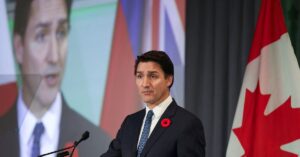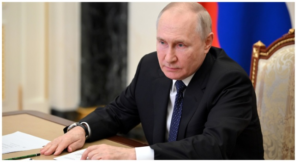
There was the carbon tax fight. Outrage over environmental assessments. And anger at the very idea of shifting away from planet-warming fossil fuels and the lucrative industry that produces them.
Now, the next flashpoint in the always-intense political debate over climate change and what to do about it could be drawing near. It involves federal plans to impose rules across Canada to slash greenhouse gas emissions from power plants.
All the familiar themes are there, from claims Ottawa is trampling into provincial jurisdiction and making life more expensive, to arguments Canada must contribute to the global struggle with climate change and position itself to profit from the world’s efforts to do so.
At least one province is already warning the incoming policy will jack up electricity bills and could jeopardize the reliability of power grids that rely on hefty amounts of natural gas — though the federal government insists the plan will be flexible enough to avoid price spikes and blackouts.
“We can expect that there will be some difficult conversations ahead on this,” predicted Jason Dion, senior research director for the Canadian Climate Institute and a member of the government’s newly-appointed advisory council on “clean electricity.”
“Part of reducing Canada’s emissions is, in many sectors, to shift from fossil fuels to electricity,” Dion told the Star this week, explaining how power grids could need at least twice as much energy in the coming decades. “We want to make sure that electricity is clean and non-emitting,” he said.
The federal government was happy to point out this week that Canada is not alone in this. On Thursday, the United States announced how it plans to regulate power plant emissions in a similar way to what Canada is contemplating. That includes the target — “net-zero” emissions from electricity by 2035 — and plans to allow natural gas plants to remain to supply power at peak demand periods.
Bronwyn Eyre, the province’s justice minister, told the Star she believes Ottawa is irresponsibly trying to phase out electricity generated by natural gas before it’s responsible to do so. She also didn’t rule out taking the matter to court, like provinces have already done with other federal climate policies, like the carbon tax and environmental assessment rules.
“We’re very, very concerned — clearly — in light of our power mix,” Eyre said, pointing to how the province relies on natural gas for a large portion of its electricity needs. Forty-one per cent of its capacity came from the fossil fuel in 2022, according to SaskPower, the provincial utility.
“We have had to face these mandates, the shifting goalposts, you know — net zero 2050; no, net zero 2035. And then that kind of glib attitude. ‘Nothing to see here. What are you complaining about?’ It’s highly condescending, for starters, and really irresponsible to flirt with mandates such as that,” Eyre said.
Asked about such concerns, Guilbeault’s office pointed to the federal environment minister’s statement Thursday welcoming draft regulations from the U.S. that he said are similar to what Canada is planning. The government, as well as some environmental policy experts, argue international alignment on the shift to clean electricity helps make the case that it’s the right course of action — especially as industries jockey to claim the products they make, from cement to aluminum and more, are not fuelling climate change.
That claim is easier to make if their factories run on zero-emission electricity.
“The integrated North American electricity grid is on the road to seizing the clean electricity advantage,” Guilbeault said. “State and provincial governments that take action now to embrace a clean electricity future will be more competitive in the North American marketplace.”
Guilbeault also confirmed the government, like the U.S., will “take into account the continuing role natural gas plays in meeting peak surge demand.”
For some environmentalists, however, there is no place for fossil fuels in Canada’s electricity grid, which is already 84 per cent emissions-free mainly because of an abundance of hydro power. But if power needs increase as expected, as industries shift from fossil fuels to electricity, it will be crucial that the power supply is free of greenhouse gas emissions, said Stephen Thomas, clean energy manager with the David Suzuki Foundation.
“The loopholes, extensions and exemptions for natural gas on the electricity grid are the biggest risk to this policy succeeding,” he said.
For Pivnick, from Clean Energy Canada, the federal rules will undoubtedly prompt divergent arguments. There will also be a financial burden in nudging the country’s electricity grid — responsible for about eight per cent of national emissions, according to the latest government tally — towards net zero.
“Of course there’s costs, we’re talking about transforming our energy system,” Pivnick said. “The question is: can we do so in a way that seizes benefits for affordability, for energy security? And the answer can be a resounding yes. But that needs to be our goals as we design these regulations.”
That claim is easier to make if their factories run on zero-emission electricity.
“The integrated North American electricity grid is on the road to seizing the clean electricity advantage,” Guilbeault said. “State and provincial governments that take action now to embrace a clean electricity future will be more competitive in the North American marketplace.”
Guilbeault also confirmed the government, like the U.S., will “take into account the continuing role natural gas plays in meeting peak surge demand.”
For some environmentalists, however, there is no place for fossil fuels in Canada’s electricity grid, which is already 84 per cent emissions-free mainly because of an abundance of hydro power. But if power needs increase as expected, as industries shift from fossil fuels to electricity, it will be crucial that the power supply is free of greenhouse gas emissions, said Stephen Thomas, clean energy manager with the David Suzuki Foundation.
“The loopholes, extensions and exemptions for natural gas on the electricity grid are the biggest risk to this policy succeeding,” he said.
For Pivnick, from Clean Energy Canada, the federal rules will undoubtedly prompt divergent arguments. There will also be a financial burden in nudging the country’s electricity grid — responsible for about eight per cent of national emissions, according to the latest government tally — towards net zero.
“Of course there’s costs, we’re talking about transforming our energy system,” Pivnick said. “The question is: can we do so in a way that seizes benefits for affordability, for energy security? And the answer can be a resounding yes. But that needs to be our goals as we design these regulations.”







